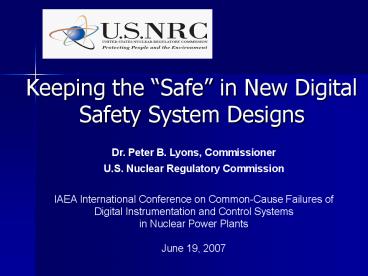Keeping the Safe in New Digital Safety System Designs - PowerPoint PPT Presentation
1 / 19
Title:
Keeping the Safe in New Digital Safety System Designs
Description:
Keeping the 'Safe' in New Digital Safety System Designs. Dr. Peter B. Lyons, Commissioner ... IAEA International Conference on Common-Cause Failures of Digital ... – PowerPoint PPT presentation
Number of Views:43
Avg rating:3.0/5.0
Title: Keeping the Safe in New Digital Safety System Designs
1
Keeping the Safe in New Digital Safety System
Designs
Dr. Peter B. Lyons, Commissioner U.S. Nuclear
Regulatory Commission IAEA International
Conference on Common-Cause Failures of Digital
Instrumentation and Control Systems in Nuclear
Power Plants June 19, 2007
2
Common-Cause Failure (CCF) of Digital IC Safety
Systems
- Practical Solutions Already Implemented
Throughout the World - Increasing Worldwide Interest in All Digital
Nuclear Plants - Continue Identifying Practical and Safe Solutions
3
U.S. Historical Perspective
- 1980s some digital components within larger
analog safety systems - CCF not a significant concern
- 1990s questions during reviews of advanced LWR
designs - Could failure probabilities be estimated?
- Was analog backup needed for CCFs?
4
National Academies of Science and Engineering
Study Panel (1997)
- To address CCFs, emphasize diversity of inputs
and algorithms, hardware, and operating systems - Agreed with NRC position that CCF could be
addressed using a variety of diversity approaches
dependent on each plant design, including diverse
digital systems
5
Historical Summary
- Very real safety benefits can be achieved
- Regulatory questions have been addressed in past
designs, but continue to persist today - Future Senior NRC/industry attention to
establish a project plan to address these
questions for new designs
6
Defense-in-Depth
- Greater inter-connection and coupling of digital
channels raise regulatory questions regarding the
adequacy of defense-in-depth - Are familiar defense-in-depth approaches
applicable to digital IC?
7
Defense-in-Depth
Redundancy
Diversity
Independence
8
The Basic Rules for Inter-connections
- 1 Determine there will actually be a safety
benefit - 2 The greater the inter-connection, the more
attention must be paid to preventing adverse
results while preserving the intended benefits
9
Key Safety Concepts
- Independence and Diversity
- Presently no other safety concepts to take their
place
10
What is Sufficient?
- How timely can we address all the new questions
raised by using digital safety system design
concepts that differ significantly from past
digital system designs? - NRC is actively updating regulatory guidance, but
will we become too prescriptive for this rapidly
changing technology?
11
The Big Picture
- PRA is a Big Picture tool that helps us better
understand overall system failure as a function
of individual failures where it is impossible to
test overall system reliability - PRA requires that we know how the various parts
of a system can fail
12
A Catalogue of Failures
- Hardware Failures
- Software Failures
- Combined/Interactive Hardware/Software Failures
- A SYSTEMATIC APPROACH
13
Operating Experience
- Gathering, Sharing, and Using It
- Safety-related and Non-Safety-Related
- Nuclear Industry and Other Industries
14
Operating Experience
- Important for systems where testing cannot be
expected to shake out all the potential failure
causes and modes
15
Test and Evaluation Facilities
- Todays NRC approach
- National Laboratories
- Universities
- International Research Centers
- Case-by-case
- Not Efficiently Integrated
- Not Keeping Pace with the Technology
16
A New Concept?
- A U.S. Research, Test, and Evaluation Facility
for digital safety systems - Attract new graduates and experienced
professionals - Participation of other government agencies and
industries
17
A New Concept?
- Public Workshop to discuss the concept of a U.S.
Research, Test, and Evaluation Facility - Location Atlanta, Georgia (tentative)
- Dates September 6-7, 2007 (tentative)
- Further Information Steven Arndt,
NRC/RES - (301) 415-6502
18
Closing Key Points
- Digital Technology can improve safety
- Achieving Defense-in-Depth requires redundancy,
diversity, independence - Need to identify and catalogue the ways that
digital systems can fail and increase our
knowledge-base with operating experience - Need to find better ways of evaluating new
digital safety system designs
19
THANK YOU!































